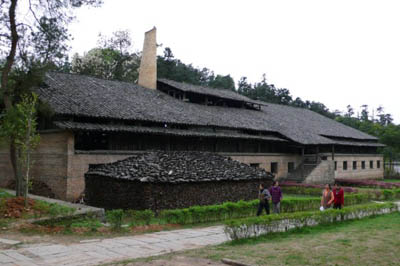Without any firings or repairs in the past 13 years, an ancient kiln in China's porcelain capital, Jingdezhen City in the eastern Jiangxi Province, was on the verge of collapse, forcing authorities to protect the only remaining relic of its type in the country.
 |
|
The only remaining kiln with a 1,700-year-old history in pottery production is called Zhenyao in Chinese.
|
The 200-square-meter kiln fired pots for the royal families during the reign of Emperor Qianlong (1711-1799) in Beijing, but now termites called it home, threatening the sturdiness of its wooden pillars, said Jiang Hua, Jingdezhen Culture Bureau director. "The erosion was due to a lack of repair."
China's pottery achieved a high level of technical competence and sophistication in the Qing Dynasty (1644-1911). More than 100 kilns in this city with a 1,700-year-old history in pottery production were firing pots, but only one remained today.
The kiln was heated by 4,000 kg of wood for each batch of pottery, usually between 20,000 to 30,000 pieces. The firing stopped in 1995. Since then, no repair work had been conducted, said Liu Junchen, deputy manager of the Ancient Kiln Porcelain Factory which runs several tourist attractions, including the last ancient kiln.
"Normally, the kiln fired pots once every week and needed repairing once every five years. As the repair work had stopped, the clay and the bricks could not be connected as closely as before," he said.
White ants were also digesting the pillars made from the most solid wood from south China that had supported the kiln for hundreds of years.
"If the damages by the white ants goes unchecked, one day, sooner or later, all the pillars will collapse," Liu told Xinhua.
"But we do not have enough funds to do the repairs. Our profits cannot meet the employees' salaries."
The kiln was significant for scientific research and tourism, added Li Jusheng, a Jingdezhen Ceramic Institute professor.
"With the last kiln, we could study how the ancient people loaded the kiln, how they controlled the temperatures and duration of the firing, how they created atmospheres within a kiln to affect the appearances of the finished wares. Some techniques were unique in the world."
Loading a kiln with wares is the most difficult part of the firing, as the placement of pieces within the kiln and the way they are placed near each other could distinctly affect the pottery's appearance. "Once the last kiln disappeared, we would lose the last opportunity to learn these techniques from our forefathers," Li said.
"The Jiangxi Provincial Culture Bureau has decided to allocate 300,000 yuan (about 44,000 U.S. dollars) to remove the threat of the white ants. The repair work would start at the end of this year," Jiang said. "We are finding the same type of wood to replace the damaged pillars."
The kiln would also restart firing after the repair work was finished. We would do firing twice every year. The kiln would remain as long as it is used."
Local authorities in Jingdezhen also strived to make the hand-made techniques more available to the public so as to preserve the art of pottery.
The Ancient Kiln Porcelain Factory employed dozens of experienced potters to display the manufacturing process, including mixing the clay, shape forming, glazing and decorating. The potters used their hands and a few simple tools, including wheels, knives and writing brushes.
The handiwork was included into the first list of China's oral and intangible cultural relics.
"Hand-building was the earliest and the most individualized forming method," Liu said. "With a high control over the speed of the wheel and the size and shape of the wares, potters could use their imagination and inspiration to create one-of-a-kind works of art. "
The Jingdezhen Education Bureau had set up pottery courses in colleges and professional schools, Jiang added. "We would continue to improve the income of the old potters and encourage them to pass on their pottery techniques to more students."